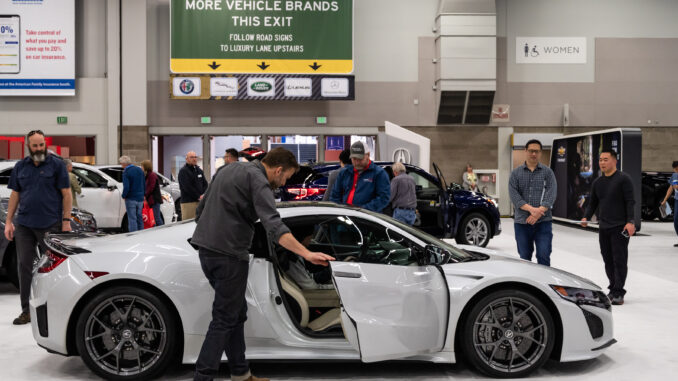
Nobody understands why car shows don’t happen in the winter.
Maybe it’s the softening of our resilience as a culture, and now we’re so coddled and fragile the idea of standing outside, in some converted parking lot or requisitioned city street, staring at a 2022 Porsche Taycan GTS Sport Turismo in high-gloss black metallic at 10:30 a.m. on Sunday, December 5th – when the forecast calls for dense fog and a high of 41-degrees – is now unbearable as is the price tag of $133,300.00 unless the viewer is Adele. Or maybe Keith Olbermann.
Or maybe it’s the reality that young people tend to believe that cars are somehow the source of many intra-planetary problems even though major manufacturers, like Porsche, make a lot of electric ones now, which is excellent, as this provides an opportunity for men to suffer through mid-life crises in ecologically beneficial ways.
This brings up the question of whether women suffer through mid-life crises. Still, we don’t think so because they don’t have time now that the expectation is for them to work full-time while still shouldering the burden – right down to the finest detail including making doctor appointments, celebrating birthdays, and buying food – of supporting the physical health and emotional well-being of any offspring and satellite family members.
This leaves the dudes ample opportunity to stand around scratching their crotches and farting while looking at cars at car shows.
And it turns out – after a grueling 122 seconds of research, which makes us wonder why our research and the fact-checking department has a staff of twelve, an annual budget of $776,000, and produces an endless stream of sarcastic commentary upon the receipt of any request that generates actual research and fact-checking work – car shows do happen in the winter as evidenced by the LA Auto Show that just happened (Nov. 19-28) and the forthcoming Chicago Auto Show (Feb. 12-21, 2022).
Sidebar: Our overpaid, snarky researchers and fact-checkers just chimed in that November is technically fall, not winter. Which we counter with the fact that most humans subliminally view the seasons in the following manner, vs. what Al Roker says:
Spring: March, April, May
Summer: June, July, August
Fall: September, October
Winter: November, December, January, February
Furthermore, we stated, which we now regret given the aggressively poor attitude of this overbudgeted department, “A season is a division of the year based on changes in weather, ecology, and the number of daylight hours in a given region, rather than a meteorological construct by wealthy television broadcasters,” with kind of an arch-eyebrowed look of superiority in both intellect and rank within our company.
To which researchers and fact-checkers pointed out, “The temperature forecast for LA on Thursday, December 2nd, includes a high of 77-degrees, so do you consider 77-degrees in North America as more of a fall temperature or a winter temperature, or what do you think about the high of 84-degrees that happened on day three of your precious LA car show?”
Which we finished with thoughts of responding, “Said the gigantic horned-rimmed bespeckled, trendy cow print wide-flare pants-wearing, obnoxious latte-with-personalized ripples drinking….”
The office manager suddenly grabbed our laptops and made us take a walk for some reason. The point is unless you’re Vanessa Hudgens or whatever, car shows never happen in winter. Except for Chicago. And as it turns out, Portland, Oregon, as the Portland International Auto Show, takes place February 23-27, 2022, a most decidedly winterish month. Please don’t tell the researchers and fact-checkers they were right.
This new information likely elicits the reaction of, “I don’t care about car shows and the overly-tanned, wrinkly, grey-haired yet salt-and-pepper handlebar mustachioed, gravelly-voiced, mechanic shirt-wearing, cigarette smoke smelling, loud-voiced dudes who attend them. Or their gigantic-bosomed wives, or the tacky car model girls…but maybe I care a little about the hot dogs at the food court or the nachos with the runny neon yellow cheese.”
But we’re here to point out this notion is dead wrong (except the food part).
Most people – meaning we polled our 12-person accounting department on the sly, which will only further upset our researchers and fact-checkers, so don’t say anything – think car shows are for gear heads aged 14-65, mechanics, father-son combos looking to bond over projects, industry representatives, and salespeople. And they’re totally right, yet mistaken, which creates a lot of internal conflict with their Chi energy or whatever. It turns out car shows are primarily platforms for:
- Knowing more about cars in general
- Learning the latest trends in car design
- FOMO but only about car stuff
- Fulfilling the fanatical, obsessive desire to own more than 8-12 cars in a lifetime, unlike the average American
- Learning about how to build a custom car
- Watch cars/manufactures get awards (really?)
- “Socialize” by meandering around with a significant other, muttering at various popped hoods, or sitting in the back seat of some unobtainable luxury vehicle, rubbing the leather and hoping there’s mints in the cupholder, then pausing at sudden genius inspiration, winking at said large bosomed spouse and – thinking the whole thing is the most original idea ever – half-seriously/half-jokingly mentioning how fun it would be to “do it” in this very nice luxury vehicle
- Get discounts on car parts
- Get better deals on buying a car okay stop just stop
Now we really regret pissing off the fact-checkers and researchers, and the office manager lectured us again. Fine. Not surprisingly, car lovers, engine lovers, and people-watching lovers go to car shows and have a blast. But regular people should go too – if they’re considering buying a car anytime soon. According to a guy from Detroit’s North American International Auto Show, these events are helpful because:
- Every single make or model is out there – and since most dealerships only sell models from a small selection of brands, shoppers who want to compare (for example) sedans would normally have to drive around to different dealers which is just such a drag.
- Speaking of slime, who wants to deal with a dealer? Auto show goers are surprised by the lack of sleazy salesmen and half-clad women (dang!) at these events, instead finding product experts there to provide information, not earn a commission. And there’s absolutely no lurking – except maybe from that guy and his wife from the sex-in-the-back- seat idea.
- Cars are confusing for average citizens, but auto companies know that industry professionals, the press and the public will be grilling their staff, so they typically bring well-qualified experts to the show; which means honest answers to any questions.
- Displays are curated with all segments placed one location. Translation: someone looking for a new family vehicle can check out SUVs, crossovers, wagons, and minivans (hahahahaha minivan? How totally lame…oh sorry) all withing the same 2000 square-foot area; a great way to whittle “top 5” lists down to “top two.”
So if those looking to buy should go to a show, almost 70% of attendees at the Washington Auto Show purchased a car within the next 12 months, according to show producer John O’Donnell. Which was kind of a “let’s make up” stat proffered by our research and fact-checking department. Fine, we’re sorry about the cow print pant wearing comment too.
Even those not looking to buy should go: The price tag for admission is relatively low (tickets for the Portland International Auto Show in February are $15, and indeed there are other shows around if one can wait that long, or neighborhood-oriented events that could fit the bill in the meantime), the people watching has to be GREAT, and there are the inevitable food courts. And mints. Plus, it’s freezing and raining in these parts this time of year – who wants to stand out in that?

